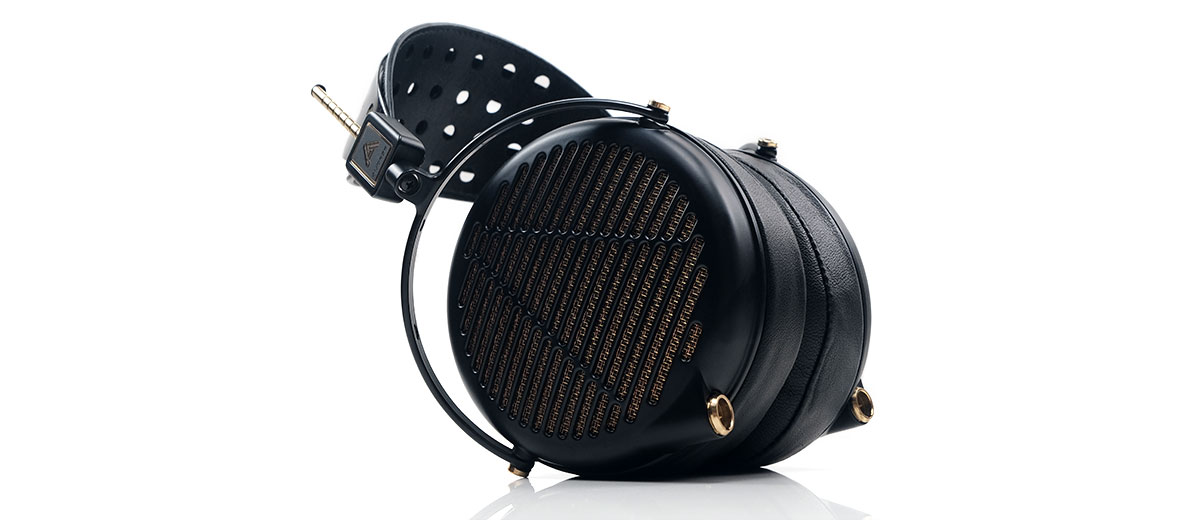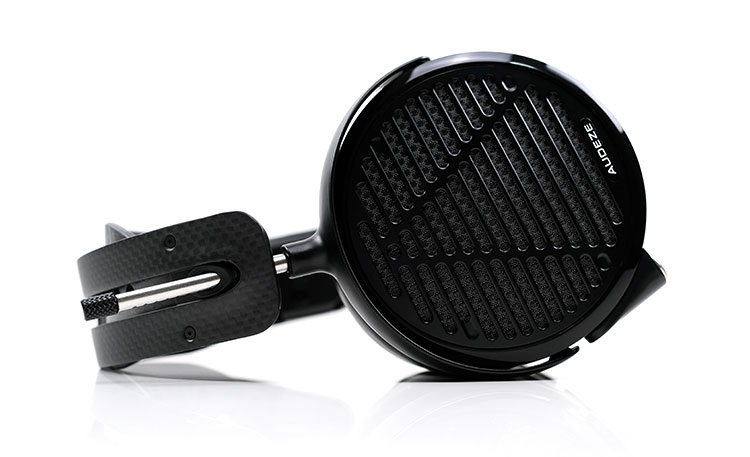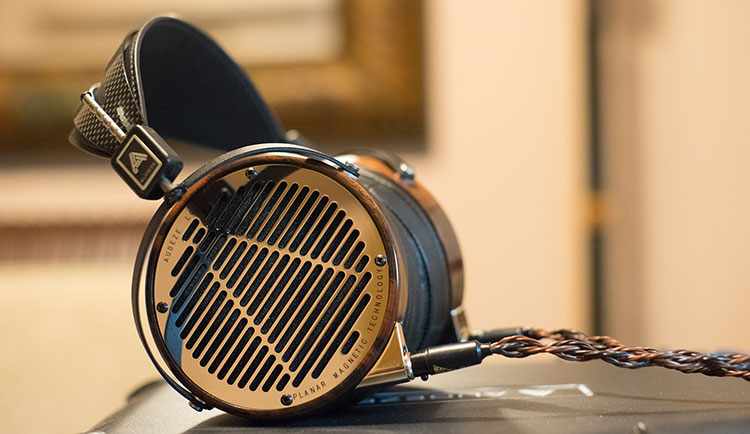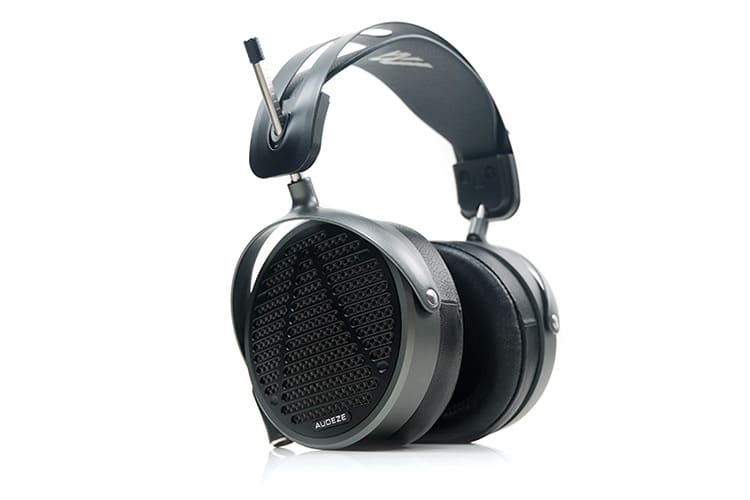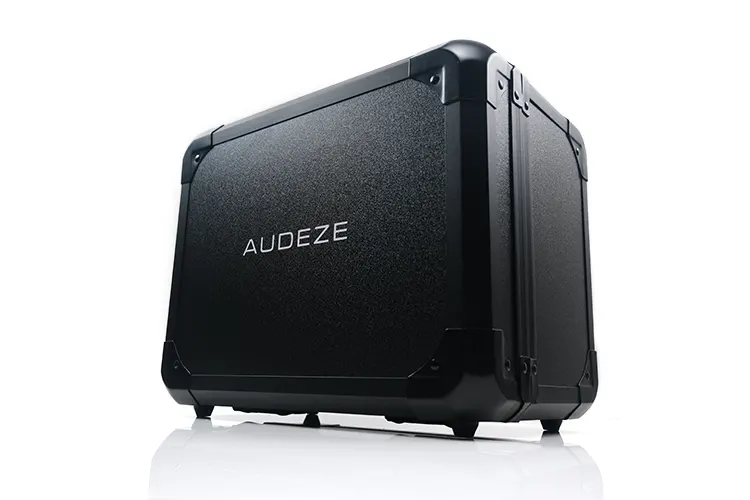Select Comparisons
The following comparisons to the LCD-4z were completed using a mix of the Ferrum OOR/HYPSOS with the Holo Audio Spring 2 Wildism Edition DAC and the iBasso DX320 MAX Ti.
Audeze LCD-5
The Flagship Series LCD-5 was launched almost exactly 3 years ago and represented a complete refresh of the design and performance of the LCD series headphones.
Technical
Despite sharing the same LCD moniker and using planar drivers, the LCD-5 is a very different beast.
Gone is the older, larger LCD-4z 106mm driver, replaced by a more compact 90mm driver with the company’s current Fazor waveguide, a similar nano-scale diaphragm thickness, but with 14 Neodymium N50 magnets in a single-sided Fluxor magnet array as opposed to dual-sided.
Some further adaptations include moving the Fazor waveguides inside the earcups with a lower profile than the LCD-4z implementation to further reduce diffractions and interactions with the ear.
Despite using a different driver, the impedance between the 14Ω LCD-5 and the 15Ω LCD-4z are almost the same.
To ensure the LCD-5 achieved the same light load, Audeze introduced a new trace pattern with varying-width parallel traces that increased voltage headroom by altering the current density within each trace.
In turn, this improved the control over the diaphragm with a more even and uniform level of force which helped to lower the distortion levels of the LCD-5 driver.
It is still a testimony to the LCD-4z that despite using an older design not only is it almost as efficient, but it is still the more sensitive of the two drivers at 98 dB/1mW compared to the LCD-5’s 90 dB/1mW rating.
Both should fare quite well from portable sources, with the LCD-4z more comfortable at lower gain levels.
Design
If you are after the lighter set of headphones then the LCD-5 is the pick. It weighs 420g which is 120g less than the LCD-4z. You can feel that difference when handling and wearing the LCD-5.
I might give the nod to the LCD-4z for comfort but that’s anecdotal and based on my head shape and perception of comfort.
For me, it comes down to the clamping pressure and shape of the pads. Fresh out of the box, the LCD-5 fluted pads have a narrower pressure point, and do less well in mitigating the clamp than the plush flat surface of the LCD-4z leather pads.
That elevated pressure from the LCD-5 setup dissipates over time but it’s still not quite as relaxing as the LCD-4z.
Both have killer design language though the more compact driver inside the LCD-5 allows Audeze to shrink the cups’ relative size, making it the more compact unit. Removing the pivot blocks with a new soft sliding adjuster rod and streamlining the carbon fiber headband further modernizes the profile.
Switching to a ‘Tortoiseshell’ dyed and polished acetate also allows Audeze to gently shift away from pure wood or blacks with that gentle warm glow from a clearly lighter enclosure.
Props though to the LCD-4z, it has bling, a vibe, and something cool about its accenting. It’s more old school, the last but one Audeze headphone design iteration but its styling still feels and looks quite modern.
Performance
Big differences everywhere. I should preface that with simple acoustics of the pad depth, opening, and driver size which creates a more ambient soundstage on the LCD-4z when compared to the LCD-5.
In turn, that pushes back the perceived stage location a little and opens up aspects of the staging size endowing the LCD-4z performance with a ‘bigger’ sound.
Ranged against this, the LCD-5 is the more intimate, the more immediate in its staging courtesy of a more forward 2-5k ear gain that tightens up the vocal quality for me but also places it front and center in its imaging focus.
You do not get that with the LCD-4z, hence you will hear comments of its more relaxed tonal quality. The dipped 2-4k range enhances the relaxing aspect, putting a bit more space between you and the singer, so while still clear and beautifully toned it’s not as ‘driven’ as the LCD-5.
The bass is where the LCD-4z shines for me, at least up to around the mids at around 1k. It’s a classic Audeze gentle lift, carrying some pleasing warmth and a little more heft sub-100Hz when compared to the LCD-5.
It doesn’t convey the same punch and speed as the LCD-5 low-end and I do find the overall definition slightly softer. However, the acoustical space afforded combined with the larger driver doubles down on what I termed as a ‘bigger sound’.
The highs are a mixed bag. Some will argue the LCD-5 is a bit closed off and ‘south of Harman’ a little beyond 5k with the LCD-4z sounding more elevated and extended in the upper treble.
The LCD-5 can sound a little hard-edged out of the box but I find that it calms down after a few hours, becoming tonally quite consistent.
Audeze LCD-4
The LCD-4 was launched around 9 years ago though to be accurate it debuted with a lower 100Ω impedance model with a subsequent replacement shortly after with the longer running 200Ω version. The version I have here is the pre-2021 pad version.
Technical
On paper, there is not a huge difference in how these headphones are engineered. Both use Audeze’s classic 106mm driver, a double Fluxor™ Neodymium N50 magnet array, and a
Nano-Scale Uniforce™ diaphragm with Fazor technology.
The notable difference is in their power requirements with the LCD-4z rated at 15Ω and needing 250mW or less maximum power and the LCD-4 rated at a much higher 200Ω with double the recommended power level at 500mW.
Where did this come from? Most likely the LCD-4z uses a much lower impedance trace compared to the LCD-4.
Whether that adapted the thickness of the deposited aluminum layer similarly to how they initially went up from 100Ω to 200Ω on the LCD-4 I am not sure but going from 200Ω down to 15Ω is a big drop.
That means the user scenario for each headphone is very different. The LCD-4z needs plenty of current and not so much voltage to sound optimal. The LCD-4 needs plenty of current and voltage to sound optimal, reducing the range of suitable amplifier pairings.
Design
The LCD-4z is the lighter and sleeker looking of the two models. The LCD-4 weighs in at a huge 690g or around 150g more than the LCD-4z and you will feel that difference right away in your hand or on your head.
You might think both are heavy but that additional 150g generates more kinetic energy from the headphones when your head moves rapidly from side to side. In short, it will wiggle around a bit whereas the LCD-4z feels much more secure with the same head motions.
The clamping on both doesn’t feel hugely different but I will give an edge to the LCD-4z for lateral comfort, if only because the LCD-4’s downward pressure is more intense and thus less pressing down on my ears and the updated 2021 pads on the LCD-4 which are softer.
Aesthetically, this is a preference thing but the slicker LCD-4z finish on the cups looks more urbanized to me compared to the stately wood and metal grill finish of the LCD-4.
You might differ and find the latter’s finish more eye-catching and I could understand why also. I would say the softer edging on the LCD-4z magnesium yoke is easier on the hand compared to the sharper edges of the LCD-4 aluminum version. That makes it a comfier headphone to handle.
Performance
This is an interesting comparison because on paper they graph in a very similar manner save for what I feel is a bit more 8-10k emphasis from the LCD-4. However, subjectively I feel they sound quite different but more on the technical side for the LCD-4 with a slight nod to the LCD-4z tonal coloration.
Both headphones have that 2-5k dip but with a suitably powered amplifier, the more demanding LCD-4 sounds more inciteful and more able to manage that dip with superior levels of clarity.
I suspect a little bit of additional contrast from the stronger upper treble helps tease out some of the more nuanced imaging in recordings but overall, I felt the LCD-4 delivered the better imaging and separation through that region.
Where the LCD-4z seems to do better is tonal consistency. It does not sound quite as contrasty on some of the upper mids percussion coloration, giving it a smoother more pleasing tone.
It is not as deep or as holographic to me ear as the lows from the LCD-4 but it can offer a quicker and more vibrant pace at times which creates a more ‘immediate’ quality to its bass performance.
The LCD-4z’s 6-7k dip is more significant to my ears than I initially thought it might be when comparing it to the LCD-4.
That dip takes a bit of that ‘zing’ out of the harmonic overtones so percussion splashes resonate less on the LCD-4z. The LCD-4 decay on the same notes is more strident, creating a more noticeable lingering effect and drawing more of your attention to those notes.
Audeze MM-500
Considering the LCD-4z has found favor with the pro-audio community I thought it would be interesting to see how one of Audeze’s newer studio-tuned models would fare against this long-standing flagship model. Enter the MM-500, albeit at a more affordable price.
Technical
The MM-500 borrows technical features from the LCD-5 and the LCD-4z. From the LCD-5, we have the LCD-5’s smaller 90mm driver size combined with its more efficient and lower impedance single-sided Fluxor™ magnet array, (14 magnets in total).
From the LCD-4z, we have the Ultra-Thin Uniforce™ diaphragm which further reduces distortion from the previous iteration of driver designs. All of the aforementioned headphones continue to use Audeze’s current Fazor waveguide.
The net result is a very similar impedance level despite the different drivers with the MM-500 rated at 18Ω and the LCD-4z’s larger 106mm driver design even more efficient at 15Ω. The MM-500 is more sensitive on paper at 100 dB/mW compared to the LCD-4z’s 98 dB/1mW rating.
Design
Perhaps one of my favorite headphone designs over the last few years. I am not saying it is the most comfortable the LCD-4z is comfier on my head despite it weighing more.
Rather it is the modern shape and muted executive coloring drawn from the LCD-5 form factor but slightly toned-down materials-wise for a more affordable price point. If the LCD-4z is peak 2021 Audeze for creativity then the MM-500 (along with the LCD-5) is peak Audeze now.
The MM-500 form factor is smaller, the traditional spring steel and machined aluminum frame weight is 50g lighter, and the styling is more minimalist compared to the gold accented bling of the LCD-4z.
Yet somehow, both have found a home in the pro-audio community. I get why, the sound signature tuning, their easy-to-drive nature, and relatively comfortable yet durable housing.
Strictly speaking, the LCD-4z gets the comfort nod. You do not feel as much lateral clamp, perhaps more vertical pressure but given it comes armed with lush and deep leather pads it’s barely noticeable.
The MM-500 clamp is a bit more noticeable. It uses a flatter pad structure compared to the LCD-5 so I rate its comfort level higher over longer listening sessions but still behind the LCD-4z lush pad fitting.
One final observation is the higher quality cable packaged with the LCD-4z. The MM-500 uses a 20AWG high-purity OCC audio-grade copper wire but it’s wrapped in a plainer finish and comes with a single-end 3.5mm termination with a 6.35m converter.
Performance
There are some similar traits in this comparison to the LCD-5 matchup. The MM-500 delivers a more intimate soundstage, a more neutral coloration with a flatter but punchier bass response.
The LCD-4z is more open-sounding; naturally so with the bigger driver and enhanced driver-to-ear distance from the deeper set of pads. It also has the 2-5k dip right where the MM-500 FR is at its most forward-sounding which enhances that perception of distance.
The MM-500 is much more mid-centric and vocal first in terms of imaging. The LCD-4z is comparatively relaxed over this region with my ear generally centering on the 100HZ to 1k region where the curve is slightly north of neutral.
I find the MM-500 the punchier of the two headphones on the lows. There is a little more contrast on the timbre to help tease out some nice definition and energy but it lacks the sheer depth and space from the warmer more voluptuous bass tuning of the LCD-4z.
Aside from a minor 7k peak on the MM-500’s treble tuning is a bit like the LCD-5, running a little south of neutral so you will not find that same level of reach as the LCD-4z or a similar sparkle. The LCD-4z does have a dip on that 7k region so it’s not an abrasive treble overtone either.
Overall, the MM-500 is an energetic tuning with a neutral coloration within an intimate soundstage. I find the LCD-4z a much smoother and more relaxing sound signature with a better sense of space and control, making it easier to hear more nuanced details from recordings.
My Verdict
I guess my initial reaction was surprise when the LCD-4z landed on my desk. Here is a headphone launched around 6 years ago and still in the flagship category and still going strong in 2024.
The easy-to-drive calling card might not be the blazing attention grabber it was back in 2018. However, for this particular sound and driver, being able to plug in a $4k headphone into an everyday DAP and get the ‘classic Audeze house sound’ rich with detail and excellent dynamics brings a smile to my face.
You also have to remember that portable gear also evolves. What was ok in 2018 for a DAP or dongle has long since been superseded in most instances by bolder-sounding options today. The LCD-4z can only benefit from that improvement.
If you have some PEQ options, then some aspects of the LCD-4Z tuning can be improved. A good desktop amplifier will not be neglected in the performance of the LCD-4z either.
In the absence of the discontinued LCD-4, the LCD-4z could be described as the last man standing for traditional Audeze hardcore fans. It’s a beautiful set of open-back headphones, with a surprisingly comfortable wearing experience, fitting for its smooth, non-fatiguing tuning.
Audeze LCD-4z Technical Specifications
- Style Over-ear, open-back
- Transducer-type Planar Magnetic
- Magnetic structure Double Fluxor™ magnet array
- Phase management Fazor™
- Magnet type Neodymium N50
- Diaphragm-type Nano-Scale Uniforce™
- Transducer size 106 mm
- Maximum SPL >130dB
- Frequency response 5Hz – 50kHz
- THD <0.1% @ 100 dB SPL
- Sensitivity 98 dB/1mW (at Drum Reference Point)
- Impedance 15 ohms
- Min recommended power >100mW
- Recommended power level >250mW
- Weight 560g




